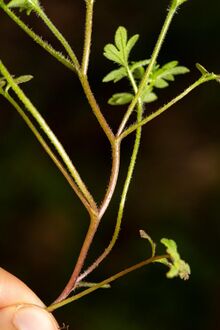Biology:Phacelia covillei
| Phacelia covillei | |
|---|---|

| |
| Scientific classification | |
| Kingdom: | Plantae |
| Clade: | Tracheophytes |
| Clade: | Angiosperms |
| Clade: | Eudicots |
| Clade: | Asterids |
| Order: | Boraginales |
| Family: | Boraginaceae |
| Genus: | Phacelia |
| Species: | P. covillei
|
| Binomial name | |
| Phacelia covillei S.Watson 1890
| |
| Synonyms[1] | |
| |
Phacelia covillei (Coville's phacelia, buttercup scorpionweed) is a North American species of annual forbs in the borage family. It is native to the eastern and central United States in scattered locations from Missouri to Maryland and North Carolina.[2][3]
Description
Phacelia covillei has slender weak stems which are 15 through 30 centimeters (6–12 inches) long, pubescent, and branched from their bases. Its leaves have 3 through 7 deeply divided lobes. It produces small, light blue-violet flowers in early spring. The flowers are on pedicels 13–17 millimeters (0.52–0.68 inches) long, in racemes of 1–6 flowers. Corolla tubes are about 6 millimeters long. Fruits are spherical capsules, 3–4 millimeters (0.12–0.16 inches) in diameter, each with 1–4 seeds.[4]
Ecology
Phacelia covillei is self-pollinating, that is, evidently not pollinated by insects or other animals, in the Potomac Gorge Area of Maryland and Virginia.[5]
Distribution and habitat
Phacelia covillei has a very limited, disjunct distribution in the eastern United States.[2][6][7] It occurs in Maryland and North Carolina (where authorities list it as S1, endangered) and in Indiana , Ohio, Virginia, and West Virginia where State Heritage Programs have not distinguished it from P. ranunculacea (Nutt.) Constance which they list as endangered in each state (Sewell 2003; Sewell and Vincent 2006). Phacelia covillei also occurs in the District of Columbia, Illinois, and Missouri where officials have not assigned it a conservation status. This species is common in some of its range where it grows in habitats such as floodplain forests and adjacent slope forests. Development, changes in land use, competition with invasive species, or a combination of these factors can eliminate populations of this species.
Taxonomy
Phacelia covillei is a member of the genus Phacelia, which was formerly placed in Hydrophyllaceae, the Waterleaf Family, but has more recently been placed in Boraginaceae, the Borage Family, in keeping with the findings of the Angiosperm Phylogeny Group.[8] Phacelia covillei has sometimes been considered an eastern cytotype of Phacelia ranunculacea,[4] which also has a very limited distribution.[9]
References
- ↑ "Phacelia covillei S. Watson – The Plant List". http://www.theplantlist.org/tpl1.1/record/tro-50244191. Retrieved January 24, 2014. The Plant List (2013). Version 1.1. Published on the Internet; http://www.theplantlist.org/
- ↑ 2.0 2.1 "Plants Profile for Phacelia covillei (Coville's phacelia)". http://plants.usda.gov/core/profile?symbol=PHCO30. Retrieved January 24, 2014. USDA, NRCS. 2014. The PLANTS Database (http://plants.usda.gov). National Plant Data Team, Greensboro, NC 27401-4901 USA.
- ↑ Biota of North America Program 2014 county distribution map
- ↑ 4.0 4.1 Britton, Nathaniel Lord & Brown, Addison (1913). An Illustrated Flora of the Northern United States, Canada and the British Possessions: From Newfoundland to the Parallel of the Southern Boundary of Virginia, and from the Atlantic Ocean Westward to the 102d Meridian, Volume 3., p. 70. Charles Scribner's Sons, New York.
- ↑ Barrows, E. M., A. F. Howard, and B. W. Steury. 2012. Fruit production and phenology of Phacelia covillei S. Watson (Hydrophyllaceae) in the Potomac River Gorge Area of Maryland and Virginia. Marilandica 3(1): 10–16.
- ↑ Sewell, M. 2003. Biosystematics of the Phacelia ranunculacea complex (Boraginaceae). M.S. thesis, Miami University, Ohio. 60 pp. http://www.ohiolink.edu/etd/view.cgi?miami1071261639
- ↑ Sewell, M., and M. A. Vincent. 2006. Biosystematics of the Phacelia ranunculacea complex (Hydrophyllaceae). Castanea 71: 192–209.
- ↑ Angiosperm Phylogeny Group. 2003. An update of the Angiosperm Phylogeny Group classification for the orders and families of flowering plants: APG II. Botanical Journal of the Linnean Society 141:399–436., cited in Walter Fertig "Farewell to the Aceraceae: Changes in the Angiosperm Family Tree". http://herbarium.dbs.umt.edu/PDF's/Spring%202011.PDF. Retrieved February 8, 2014. The University of Montana Herbarium Newsletter. (Spring 2011). University of Montana, Missoula, MT. http://herbarium.dbs.umt.edu
- ↑ "Plants Profile for Phacelia ranunculacea (oceanblue phacelia)". http://plants.usda.gov/core/profile?symbol=PHRA3. Retrieved February 9, 2014. USDA, NRCS. 2014. The PLANTS Database (http://plants.usda.gov). National Plant Data Team, Greensboro, NC 27401-4901 USA.
- Phacelia covillei. Retrieved March 12, 2017. NatureServe.
External links
Wikidata ☰ Q16987911 entry
 |




